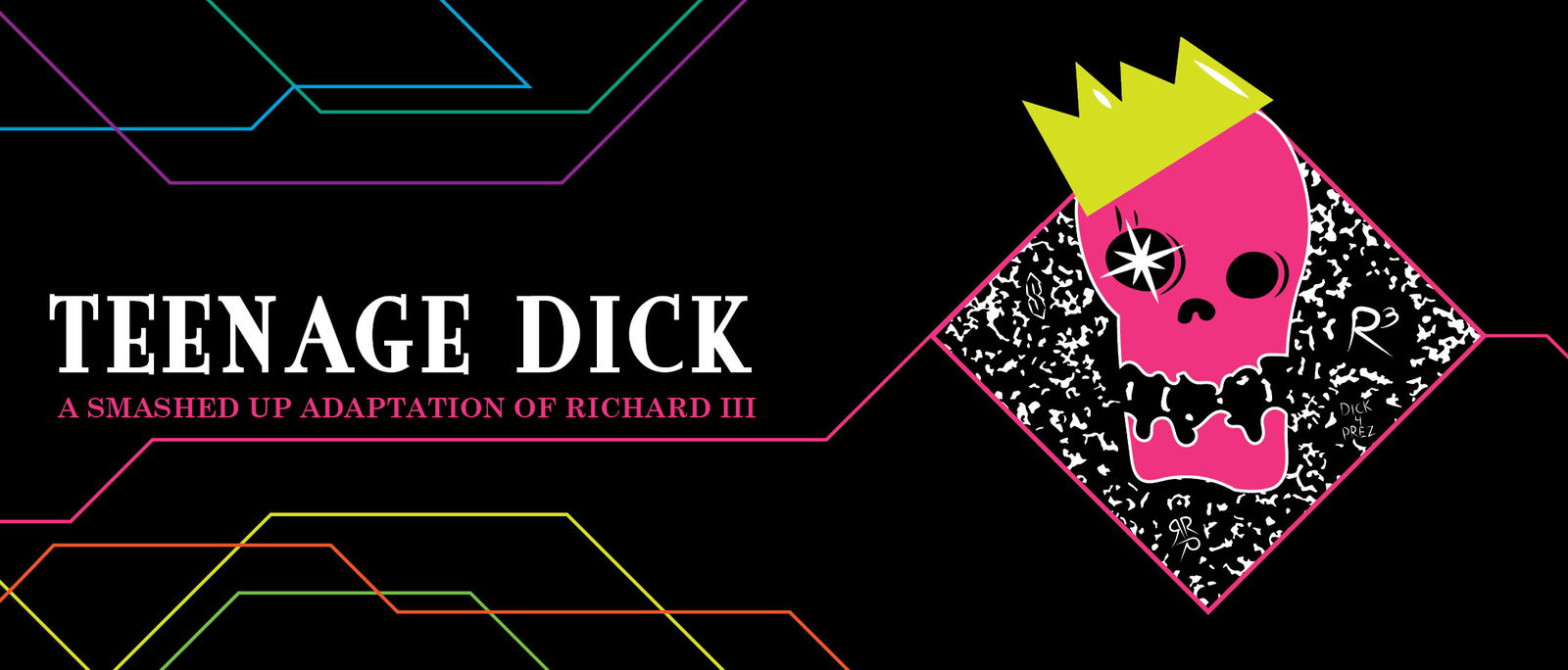It’s the last week of working in the rehearsal room for TEENAGE DICK, and the focus is on refining and enriching the actors’ work before they move into the theatre next week: adding layers to characters and relationships, getting punches exactly right, building the rhythm of the whole play precisely. This must be completed before moving onto the stage because for several days next week, the focus will be entirely on the technical aspects and not on the actors.
ELIZABETH TAVARES
Over the Break, Unto the Breach
“I have not sounded him, nor he deliver’d His gracious pleasure any way therein.”
— Scene 3, Act 4, Richard III
Today’s rehearsal was entirely focused on the mechanics of dramaturgy—choreography done at half-speed, comparing stage blood viscosities, a Q&A session the morning after a first full run-through—in which theatre looks least like its final form. It is a day when the ensemble is being sounded, not in the senses of an instrument or to complete a task fully, but as to be tested. At the end of a long morning and early afternoon of fight choreography, the cast assembled on the couches and cushions huddled at the back of the rehearsal room, tucking in to the comfort of experienced furniture.
The discussion was one ostensibly to receive notes in response to the first full run-through of the play the day before. Director Josh Hecht first asked for questions rather than launch into giving direction, taking the temperature of the group while generously weaving feedback in between. The main concern was about achieving the sharp tonal shift in the last act. Woodwind musicians call this “going over the break”: on a clarinet, a musician has to make a unique leap in dexterity to cross over from the lower register of the instrument to its upper octaves. The difficulty lies in having to go from covering no holes to covering all seven holes as well as holding down keys with both pinkies in one simultaneous gesture. When done correctly, an audience doesn’t (or at least shouldn’t) notice that you’ve taken a leap or that anything difficult has happened. In Shakespeare’s day, this was called sprezzatura: to make something knowingly difficult seem effortless. In this case, the challenge seemed to be how to hide the emotional seam of transitioning from dark humor to tragedy.
The ensemble is clearly hungry to get out of the concrete cavern of the rehearsal room and from under the tyranny of a cacophonous HVAC system, hoping that on a proper stage the seam isn’t as apparent as they feel. As one actor put it, working in the space “sucks your soul out of your eyeballs.” There is a delicious irony that they are waiting for an adaptation of a medieval play, EVERYBODY (which is a brilliant thing you need to experience immediately), to complete its run before they load in a Renaissance adaptation—as if the evolution of English drama itself is writ small in Artists Rep’s season.
Hecht gave a series of notes that had to do with “colors” as a way to capture particular attitudes. For Chris Imbrosciano (Richard), he was interested in emphasizing the delight in “using words others don’t understand” because the character’s nerdiness is a “place where you beat everyone.” He was asking for the actor to revel in an attitude of “don’t touch my Magic™ cards” rather than in Bad Guy Plans. Likewise of Ayanna Berkshire (Mrs. York) he asked to “find the crumb of Elizabeth’s panic just underneath,” while of Kailey Rhodes (Anne) it was to find the “Reese Witherspoon election version” of her character. Such notes reminded me of a beloved orchestra conductor, a bassoonist, who asked me once to perform a musical line “like linguine, not spaghetti.”
Like the mixed metaphors in my observations of fight choreography last week, the similes here seem silly out of context, but are revelatory in the moment. Often actors will play with the comment immediately upon receipt, test out a phrase with the relevant intonation eliciting laughter from one another but also immediately applying the new knowledge. Popular references to Top Chef, bitter queens, Legally Blonde, and dry martinis do far more than make a moment in elevated play relatable; they identify discrete kits of conventions, catch-phrases, accents, and dispositions that help an actor by narrowing the range of options. The first thing Gordon Ramsay does in any episode of Kitchen Nightmares is make over the menu, usually by pairing down the options. Allusions to popular culture in direction seems to achieve something similar, wherein the director is pre-selecting and curating a successful toolbox of haptics, leaving the actor with a range of—but not infinite—choices.
JIM MAYER
This was my second observation of fight choreography, though the first time did not include this big fight scene between Richard and Eddie. Jonathan said the approach today would be to run at ¾ speed. Apparently their next practice is early next week on the stage.
First, they did a slow-motion run-through of the entire fight. Then followed a breaking apart of the scene into parts, which seemed to identify these segments:
1- At the line, “You’re a fuckin’ asshole,” Eddie makes an explosive move toward Richard, driving him backward. Jonathan made a football tackle comparison, getting Eddie to hit Richard even lower.
2- Add the part where Eddie takes Richard to the ground. Here it was brought up that hip pads for Richard are coming, which is a good thing as poor Chris already has had bruising on his elbow and hip.
3- Richard rolls into Eddie (rather than away from him) then crawls away from Richard.
4- Eddie follows, gets on top of Richard with a drawing-a-bow motion to start a punch, then punches Richard’s face — really his own hand — as Richard turns his face away from the audience.
5- Eddie twists Richard’s arm up, starts kicking him in the side. Here, Josh emphasized the importance of the variety of vocal responses Richard needed to make.
6- Eddie throws Richard’s hand down to the ground. Jonathan’s suggestion that Richard turn his hand so as to hit the ground with palm down seemed to be to avoid injury and to make a sound.
7- Richard now on his right side, Eddie repeatedly punches him in the head — actually in Richard’s right arm.
8- Eddie’s blows to Richard’s stomach with Richard’s vocal reactions after each punch.
9- Eddie stands up, says “This one’s for Buck,” then kicks Richard in the gut.
There was primer-style of instruction/practice going on, except for the fact they didn’t repeat the previous segment before working on the next one. Just before break, the two actors did a slow walk-through that had a dance-like feel to it.
Near the end of the break, they prepared some fake blood capsules and discussed how many options Richard has for storing the capsules, e.g., in the web of his fingers, before putting it in his mouth. A piece of sponge was drenched in the fake blood for Eddie’s pocket so he could douse his fist in it after the punching.
After the break, they worked first on the end of the fight scene so that blood could be involved-still a work in progress. A challenge is that Richard needs to show blood is coming from his nose as well as his mouth.
Next, they moved on to the wedgie scene. One adjustment I noted is that now Eddie turns Richard so the audience can see the beginning of the wedgie, but also so we can see both their faces.
Next came practice on the end-of-assembly scene with Eddie & Richard. The goal seemed to make it slightly less aggressive, but also have Eddie trip Richard at the end, then walk off.
Next, the scene in which Buck runs over Richard’s foot. Wow, I totally missed this the first time – I thought Buck hits Richard in the balls. One adjustment to help sell it is having Buck lift the wheelchair and slam it on Richard’s foot.
Next came a scene I had not seen them work on the first day of fight choreography: Elizabeth comes in just after Richard’s been beaten. They worked on Richard pulling away from Elizabeth.
It was time for me to leave, but I’d like to mention two thoughtful gestures. First, just before the fight choreography session, Nick took me into the Morrison stage and explained the layout, including where the tweet projections would be done. And second, Karen [stage manager] showed me her thick blocking notebook and gave me a sense of her immense responsibilities. She did say that the process becomes less stressful for her the closer they get to the performance. Seems counterintuitive, but I think I understand.


